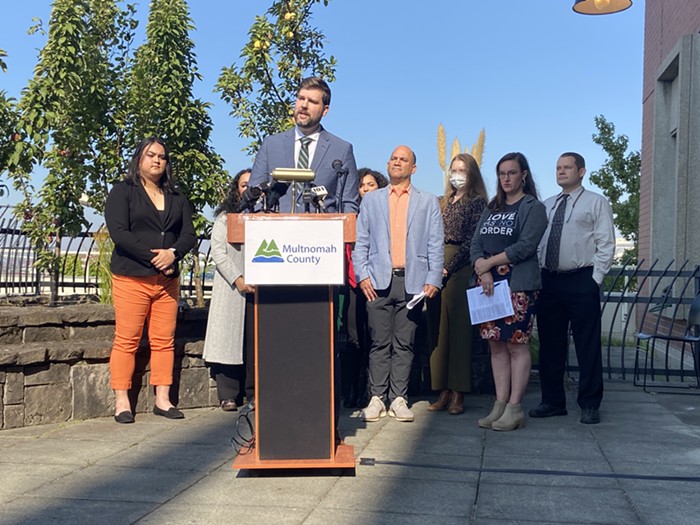Nothing about the white two-story house in Southeast Portland is out of the ordinary. It's quiet, with a manicured lawn, tucked into a similarly plain neighborhood. It hardly deserves a second glance—which is exactly what the occupants are going for.
Behind its bland front façade, the house is an asylum for victims of a darker side of society: the child sex-trafficking industry.
With few models to base the shelter off of, the dedicated group of community organizations that drew together to create the new long-stay refuge essentially built it from the ground up. Portland's shelter is more or less flying blind, pouring $300,000 and years of work into an innovative program. The experts who put the shelter together are putting their faith in a surprising place: trusting teens.
Building an honest and open relationship with adults is vital to the young victims' recovery. Rather than being a traditional lockdown facility, the shelter is built around the idea of openness and inclusion.
MISSING THE NUMBERS
Statistics about child sex trafficking are completely unreliable, as victims rarely report cases, so there's no irrefutable evidence that child sex trafficking in Portland is more prevalent than in any other major city. But unlike other major cities, Portland has put real money toward the problem. The youth shelter, which opened in December after years of behind-the-scenes work, is, sadly, more of a unique situation than it should be. Multnomah County Commissioner Diane McKeel, one of the leading supporters of the county's efforts to fund the shelter in August, has been working hard to secure more solidified shelters across the city for this need.
"I always thought of sex trafficking as more of an international, rather than a domestic, issue," says McKeel. "But it's happening here and now. These are our children. Let's take this to the next level."
Nationally, the US State Department estimates that around 100,000 children are trafficked each year—but it's equally hard to count on the accuracy of this approximation. The challenge of identifying these victims, as well as their pimps, biases statistics of the local trafficking problem, minimizing the enormity of the issue. Sergeant Mike Geiger at Portland Police Bureau's (PPB) Human Trafficking Unit estimates that the unit picks up an average of two trafficked children a week. But, "it ebbs and flows," he says.
A PRICKLY PAST
Whether its reputation is deserved or not, Portland launched into the national media as a hotspot for child sex trafficking in 2009, when a cross-country FBI sex work sting picked up seven underage prostitutes in the Rose City—ranking second only to Seattle and scoring us the nickname "Pornland" from Dan Rather. ["Confessions of a Teenage Prostitute," Feature, Sept 3, 2009]. Following the negative publicity, the Oregon House of Representatives passed a bill distributing stickers about the state's human sex-trafficking hotline. But if an underage sex worker called the hotline looking for help, the best they could hope for was to wind up in a local youth shelter that deals with all sorts of kids, not just those exploited by sex trafficking. In November 2010, Mayor Sam Adams announced that "Portland has a reputation for sustainability, as a livable place," but that reputation has been "stained by becoming a hub for juvenile sex trafficking."
For the first time in decades, local child-sex-trafficking combatants have hope and excitement for real, long-term change.
NOT YOUR TYPICAL SHELTER
With few examples on which to model the shelter, the dedicated group of community organizations that drew together to create the new long-stay refuge essentially built it from scratch.
Unlike the handful of other sex-trafficking shelters in the country, Portland's shelter is aiming to feel more like a friendly home than an institution—it won't be locked down, so the youth can leave whenever they want. It's also the only shelter to work with kids of all genders (it already has one transgender teen client). Welcoming victims with diverse backgrounds—and getting them to voluntarily stick around—is complicated.
"What if the child is Native American? Has children of their own? Doesn't speak English?" asks Joslyn Baker, collaboration specialist at Multnomah County's Commercial Sexual Exploitation of Children (CSEC) program. "There are lots of teenagers with lots of layers that need individual attention. We have developed a place that responded to these needs."
Instead of solely targeting the issue at hand, sexual abuse, the shelter encompasses all relevant adolescent problems, completing the picture.
Along with seven bedrooms, a kitchen, and living room, the space offers on-site tutoring for students who may be years behind their grade level, on-call counseling, and legal advocacy. The shelter will work with anyone under 18, but according to the PPB's Geiger, the average age for child sex workers in Portland is between 12 and 14 years of age. The shelter is designed to focus on all the bumpy aspects of adolescence with the added trauma of being exploited by trafficking.
"Now that there is a long-term, population-specific shelter available, we have the next step to care in place," says Esther Nelson, program manager for Portland's Sexual Assault Resource Center (SARC), who usually deals with emergency, short-term situations. "I am hopeful."
FROM THE GROUND UP
According to Baker of the CSEC, it took the right combination of people—and some financial support—to get the shelter up and running.
"We were already on the right path in 2009—we just needed that extra boost," Baker says. "The system was overwhelmed with need and underwhelmed with funding."
In 2010, they got that boost by receiving a $47,000 grant from a melting pot of city and local church funds and then $258,000 in funding from the county in August, cementing the shelter's future. Five organizations teamed up to develop the shelter: PPB's Human Trafficking Unit, social service agency Janus Youth, SARC, CSEC, and counseling center LifeWorks NW, which works with adult sex workers.
"We feel strongly that long-term, consistent attachments to safe adults is one of the key factors that can assist youth in their healing process," says Nelson of SARC.
SETTING THE STAGE
Prior to the shelter's development, child sex-trafficked victims taken off the street were sent to Harry's Mother, a Janus Youth runaway crisis shelter, or the program's main office. "A crisis shelter is always in crisis," says shelter director and Janus Youth veteran Kevin Donegan. He and others think it's crucial to not just make another crisis shelter, but to establish a calm environment where children are surrounded by similar peers, with the intention of setting an entirely new stage for growth.
"This isn't an institutional, lockdown facility. I won't be tackling anyone who wants to leave," says Donegan. "All I ask for is a conversation before they leave to make sure they're safe."
The inside of the house echoes this idea. The seven bedrooms each look like pages out of a Pottery Barn catalog, equipped with colorful, comfortable furniture, stuffed animals, a box of chocolates, and a basket of first-aid and health needs. The living room hosts a large wrap-around couch fit for movie watching—Donegan offers his Netflix account to all guests—and a hefty stack of board games. The only unusual decor is a pair of surveillance cameras in each hallway. The shelter aims for rescued kids to stay among the counselors and comfy sofas for at least 30 days, but they can stay for as long as a year. Parents have to consent to their kids' stay at the facility, though Donegan says that most family members are happy to have their child in a safe space rather than in an unknown, dangerous location.
Up to the point where they reach the shelter, the adult authority figures that most of the troubled teens have come into contact with is often the least trusted: the police.
"The child's pimp teaches these children that the police are the bad guys," says PPB's Geiger. "The biggest challenge we face is redirecting a child's thought that we are safe and that they are not the criminal, but the victim." Once the police find the child, it could take months to get the name of their pimp from them, giving the trafficker ample time to leave the area. Geiger says he hopes the new shelter's comfortable and stress-free environment will bring more victims out of the woodwork.
"With this level of trauma, there's no quick solution here," says Geiger. "But I think we can be encouraged that we've not just abandoned the issue, we're moving it in the right direction."














